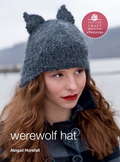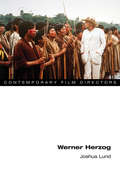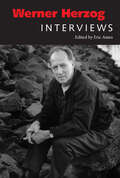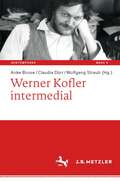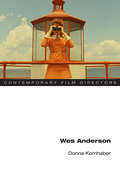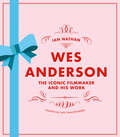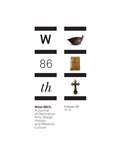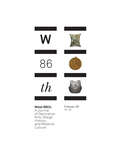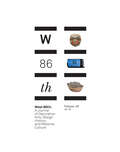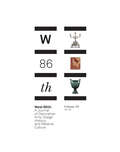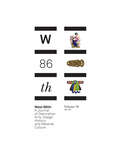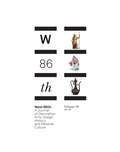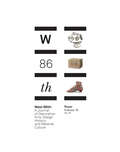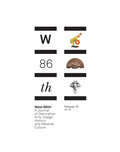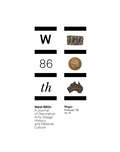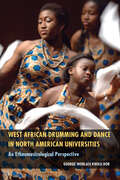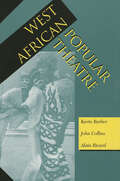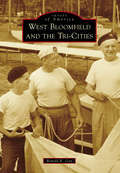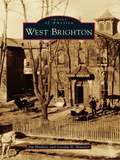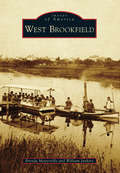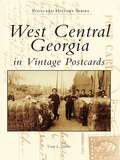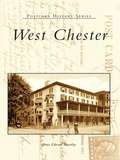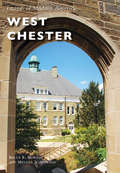- Table View
- List View
Werewolf Hat: E-Pattern from Vampire Knits (Potter Craft ePatterns)
by Abigail HorsfallInstructions for making a werewolf hat.
Werner Herzog (Contemporary Film Directors #155)
by Joshua LundWerner Herzog's protean imagination has produced a filmography that is nothing less than a sustained meditation on the modern human condition. Though Herzog takes his topics from around the world, the Americas have provided the setting and subject matter for iconic works ranging from Aquirre, The Wrath of God and Fitzcarraldo to Grizzly Man. Joshua Lund offers the first systematic interpretation of Werner Herzog's Americas-themed works, illuminating the director's career as a political filmmaker—a label Herzog himself rejects. Lund draws on materialist and post-colonial approaches to argue that Herzog's American work confronts us with the circulation, distribution, accumulation, application, and negotiation of power that resides, quietly, at the center of his films. By operating beyond conventional ideological categories, Herzog renders political ideas in radically unfamiliar ways while fearlessly confronting his viewers with questions of world-historical significance. His maddeningly opaque viewpoint challenges us to rethink discovery and conquest, migration and exploitation, resource extraction, slavery, and other foundational traumas of the contemporary human condition.
Werner Herzog: Interviews (Conversations with Filmmakers Series)
by Eric AmesOver the course of his career, legendary director Werner Herzog (b. 1942) has made almost sixty films and given more than eight hundred interviews. This collection features the best of these, focusing on all the major films, from Signs of Life and Aguirre, the Wrath of God to Grizzly Man and Cave of Forgotten Dreams. When did Herzog decide to become a filmmaker? Who are his key influences? Where does he find his peculiar themes and characters? What role does music play in his films? How does he see himself in relation to the German past and in relation to film history? And how did he ever survive the wrath of Klaus Kinski? Herzog answers these and many other questions in twenty-five interviews ranging from the 1960s to the present. Critics and fans recognized Herzog's importance as a young German filmmaker early on, but his films have attained international significance over the decades. Most of the interviews collected in this volume—some of them from Herzog's production archive and previously unpublished—appear in English for the very first time. Together, they offer an unprecedented look at Herzog's work, his career, and his public persona as it has developed and changed over time.
Werner Kofler intermedial (Kontemporär. Schriften zur deutschsprachigen Gegenwartsliteratur #6)
by Anke Bosse Claudia Dürr Wolfgang StraubIn wenigen schriftstellerischen Œuvres steht die Reflexion zeitgenössischer Medienpraxis sowie die Medialität des eigenen Schreibens so im Zentrum wie im Werk Werner Koflers. Die Beiträge zu Kofler intermedial untersuchen die verschiedenen Aspekte des Medienwechsels und der intermedialen Bezüge in seinen Prosatexten, seinen auditiven und filmischen Arbeiten. Dadurch entsteht ein Gesamtbild eines in seinen verschiedenen medialen Ausformungen motivisch und thematisch intensiv verwobenen Werks – von intertextuellen Aspekten über die enorme Bedeutung von Musik bis zur Verknüpfung mit Fotografie.
Wes Anderson (Contemporary Film Directors)
by Donna KornhaberThe Grand Budapest Hotel and Moonrise Kingdom have made Wes Anderson a filmmaking force. Rushmore and The Royal Tenenbaums have become quotable cult classics. Yet every new Anderson release brings out droves of critics eager to charge him with stylistic excess and self-indulgent eclecticism. Donna Kornhaber approaches Anderson's style as the necessary product of the narrative and thematic concerns that define his body of work. Using Anderson's focus on collecting, Kornhaber situates the director as the curator of his filmic worlds, a prime mover who artfully and conscientiously arranges diverse components into cohesive collections and taxonomies. Anderson peoples each mise-en-scéne in his ongoing "Wesworld" with characters orphaned, lost, and out of place amidst a riot of handmade clutter and relics. Within, they seek a wholeness and collective identity they manifestly lack, with their pain expressed via an ordered emotional palette that, despite being muted, cries out for attention. As Kornhaber shows, Anderson's films offer nothing less than a fascinating study in the sensation of belonging--told by characters who possess it the least. Covering Anderson's entire oeuvre and including an interview with the director, Wes Anderson is an entertaining look at one of our most beloved and polarizing filmmakers.
Wes Anderson: The Iconic Filmmaker and His Work (Iconic Filmmakers)
by Ian NathanThe definitive unofficial reference for fans of the beloved film director: “Like strolling through the distinctly colored halls of Anderson’s imagination.” —Highbrow MagazineLoaded with rich imagery and detailed analysis of his incredible films—among them The Grand Budapest Hotel, Rushmore, The Royal Tenenbaums, Moonrise Kingdom, and The French Dispatch—this is an intelligent and thoughtful examination of the work of one of contemporary film’s greatest visionaries, charting the themes, visuals, and narratives that have come to define Wes Anderson’s work and contributed to his films an idiosyncratic character that’s adored by his loyal fans.From his regular cast members such as Bill Murray and Owen Wilson to his instantly recognizable aesthetic, recurring motifs, and scriptwriting processes, this unauthorized in-depth collection reveals how Wes Anderson became one of modern cinema’s most esteemed and influential directors.
Wes Craven: Interviews (Conversations with Filmmakers Series)
by Shannon Blake SkeltonWith a career spanning four decades, Wes Craven (1939–2015) bridged independent exploitation cinema and Hollywood big-budget horror. A pioneer of the modern horror cinema, Craven directed such landmark films as The Last House on the Left, The Hills Have Eyes, A Nightmare on Elm Street, and Scream—considered not only classics of the genre, but examples of masterful filmmaking. Producing an impressive oeuvre that mixed intellectual concerns and political ideas, Craven utilized high-tension suspense, devastating visual brutality, and dark humor to evoke a unique brand of fear. Moreover, his films draw attention to the horror of American society—namely racism, classism, and the traumas often associated with family. This collection of twenty-nine interviews—spanning from 1980 until his final interview in 2015—traces Craven’s life and career, from his upbringing in a strict religious family and his life as an academic to his years toiling in exploitation cinema. The volume also chronicles Craven’s ascendancy as an independent director, his work within the studio system, and his eventual triumph in mainstream cinema. Within the interviews gathered here, including three previously unpublished pieces, Craven reflects on failed projects and the challenges of working with studios while offering thoughtful meditations on the dynamics and appeal of horror. Wes Craven: Interviews cements Craven’s legacy as a master of horror who left an indelible mark on the genre by forever altering expectations of—and approaches to—the cinema of fear.
Wesley Chapel (Images of America)
by Madonna Jervis WiseWesley Chapel originated in the mid-1800s as a cohesive community of settlers who demonstrated a uniquely rural authenticity and independence of spirit. Evidence of Native American presence in the area has been documented as early as 10,000 BC. Lumber harvesting and turpentine production became prominent industries, while cash-crop farming, citrus, and livestock ranching provided sustenance for the pioneer settlement. Charcoal kilns, gator hunting, and moonshine stills supplemented incomes and spawned legends. The community was also identified by the monikers Gatorville, Double Branch, and Godwin. From 1897 to 1902, Wesley Chapel boasted its own post office, two sawmills, and a general store. Primitive roads left residents with an informal town nucleus, and services shifted to surrounding towns until the late 20th century, when postal service and incorporation emerged, and the lumber trusts of John D. Rockefeller, Otto Hermann Kahn, and Edwin Wiley morphed into sizeable ranches.
West 86th: A Journal of Decorative Arts, Design History, and Material Culture, volume 28 number 1 (Spring-Summer 2021)
by West 86th: A Journal of Decorative Arts, Design History, and Material CultureThis is volume 28 issue 1 of West 86th: A Journal of Decorative Arts, Design History, and Material Culture. Focusing on the decorative arts, design history, and material culture, West 86th provides a forum for new research into all aspects of the content, meaning, and significance of material objects in history. West 86th publishes scholarly articles; review articles; primary source translations; critical book, catalogue, and exhibition reviews; research inquiries; letters to the editor; and supplementary digital material integral to articles.
West 86th: A Journal of Decorative Arts, Design History, and Material Culture, volume 28 number 2 (Fall-Winter 2021)
by West 86th: A Journal of Decorative Arts, Design History, and Material CultureThis is volume 28 issue 2 of West 86th: A Journal of Decorative Arts, Design History, and Material Culture. Focusing on the decorative arts, design history, and material culture, West 86th provides a forum for new research into all aspects of the content, meaning, and significance of material objects in history. West 86th publishes scholarly articles; review articles; primary source translations; critical book, catalogue, and exhibition reviews; research inquiries; letters to the editor; and supplementary digital material integral to articles.
West 86th: A Journal of Decorative Arts, Design History, and Material Culture, volume 29 number 1 (Spring-Summer 2022)
by West 86th: A Journal of Decorative Arts, Design History, and Material CultureThis is volume 29 issue 1 of West 86th: A Journal of Decorative Arts, Design History, and Material Culture. Focusing on the decorative arts, design history, and material culture, West 86th provides a forum for new research into all aspects of the content, meaning, and significance of material objects in history. West 86th publishes scholarly articles; review articles; primary source translations; critical book, catalogue, and exhibition reviews; research inquiries; letters to the editor; and supplementary digital material integral to articles.
West 86th: A Journal of Decorative Arts, Design History, and Material Culture, volume 29 number 2 (Fall-Winter 2022)
by West 86th: A Journal of Decorative Arts, Design History, and Material CultureThis is volume 29 issue 2 of West 86th: A Journal of Decorative Arts, Design History, and Material Culture. Focusing on the decorative arts, design history, and material culture, West 86th provides a forum for new research into all aspects of the content, meaning, and significance of material objects in history. West 86th publishes scholarly articles; review articles; primary source translations; critical book, catalogue, and exhibition reviews; research inquiries; letters to the editor; and supplementary digital material integral to articles.
West 86th: A Journal of Decorative Arts, Design History, and Material Culture, volume 30 number 1 (Spring-Summer 2023)
by West 86th: A Journal of Decorative Arts, Design History, and Material CultureThis is volume 30 issue 1 of West 86th: A Journal of Decorative Arts, Design History, and Material Culture. Focusing on the decorative arts, design history, and material culture, West 86th provides a forum for new research into all aspects of the content, meaning, and significance of material objects in history. West 86th publishes scholarly articles; review articles; primary source translations; critical book, catalogue, and exhibition reviews; research inquiries; letters to the editor; and supplementary digital material integral to articles.
West 86th: A Journal of Decorative Arts, Design History, and Material Culture, volume 30 number 2 (Fall-Winter 2023)
by West 86th: A Journal of Decorative Arts, Design History, and Material CultureThis is volume 30 issue 2 of West 86th: A Journal of Decorative Arts, Design History, and Material Culture. Focusing on the decorative arts, design history, and material culture, West 86th provides a forum for new research into all aspects of the content, meaning, and significance of material objects in history. West 86th publishes scholarly articles; review articles; primary source translations; critical book, catalogue, and exhibition reviews; research inquiries; letters to the editor; and supplementary digital material integral to articles.
West 86th: A Journal of Decorative Arts, Design History, and Material Culture, volume 31 number 1 (Spring-Summer 2024)
by West 86th: A Journal of Decorative Arts, Design History, and Material CultureThis is volume 31 issue 1 of West 86th: A Journal of Decorative Arts, Design History, and Material Culture. Focusing on the decorative arts, design history, and material culture, West 86th provides a forum for new research into all aspects of the content, meaning, and significance of material objects in history. West 86th publishes scholarly articles; review articles; primary source translations; critical book, catalogue, and exhibition reviews; research inquiries; letters to the editor; and supplementary digital material integral to articles.
West 86th: A Journal of Decorative Arts, Design History, and Material Culture, volume 31 number 2 (Fall-Winter 2024)
by West 86th: A Journal of Decorative Arts, Design History, and Material CultureThis is volume 31 issue 2 of West 86th: A Journal of Decorative Arts, Design History, and Material Culture. Focusing on the decorative arts, design history, and material culture, West 86th provides a forum for new research into all aspects of the content, meaning, and significance of material objects in history. West 86th publishes scholarly articles; review articles; primary source translations; critical book, catalogue, and exhibition reviews; research inquiries; letters to the editor; and supplementary digital material integral to articles.
West 86th: A Journal of Decorative Arts, Design History, and Material Culture, volume 32 number 1 (Spring-Summer 2025)
by West 86th: A Journal of Decorative Arts, Design History, and Material CultureThis is volume 32 issue 1 of West 86th: A Journal of Decorative Arts, Design History, and Material Culture. Focusing on the decorative arts, design history, and material culture, West 86th provides a forum for new research into all aspects of the content, meaning, and significance of material objects in history. West 86th publishes scholarly articles; review articles; primary source translations; critical book, catalogue, and exhibition reviews; research inquiries; letters to the editor; and supplementary digital material integral to articles.
West African Drumming and Dance in North American Universities: An Ethnomusicological Perspective
by George Worlasi DorMore than twenty universities and twenty other colleges in North America (USA and Canada) offer performance courses on West African ethnic dance drumming. Since its inception in 1964 at both UCLA and Columbia, West African drumming and dance has gradually developed into a vibrant campus subculture in North America. The dances most practiced in the American academy come from the ethnic groups Ewe, Akan, Ga, Dagbamba, Mande, and Wolof, thereby privileging dances mostly from Ghana, Togo, Benin, Senegal, Mali, Guinea, and Burkina Faso. This strong presence and practice of a world music ensemble in the diaspora has captured and engaged the interest of scholars, musicians, dancers, and audiences. In the first-ever ethnographic study of West African drumming and dance in North American universities, the author documents and acknowledges ethnomusicologists, ensemble directors, students, administrators, and academic institutions for their key roles in the histories of their respective ensembles. Dor collates and shares perspectives including debates on pedagogical approaches that may be instructive as models for both current and future ensemble directors and reveals the multiple impacts that participation in an ensemble or class offers students. He also examines the interplay among historically situated structures and systems, discourse, and practice, and explores the multiple meanings that individuals and various groups of people construct from this campus activity. The study will be of value to students, directors, and scholars as an ethnographic study and as a text for teaching relevant courses in African music, African studies, ethnomusicology/world music, African diaspora studies, and other related disciplines.
West African Popular Theatre (Drama And Performance Studies)
by John Collins Alain Ricard Karin Barber" . . . a ground-breaking contribution to the field of African literature . . . " —Research in African Literatures"Anyone with the slightest interest in West African cultures, performance or theatre should immediately rush out and buy this book." —Leeds African Studies Bulletin"A seminal contribution to the fields of performance studies, cultural studies, and popular culture. " —Margaret Drewal"A fine book. The play texts are treasures." —Richard BaumanAfrican popular culture is an arena where the tensions and transformations of colonial and post-colonial society are played out, offering us a glimpse of the view from below in Africa. This book offers a comparative overview of the history, social context, and style of three major West African popular theatre genres: the concert party of Ghana, the concert party of Togo, and the traveling popular theatre of western Nigeria.
West Bloomfield and the Tri-Cities
by Ronald K. GayWest Bloomfield Township, located 30 miles northwest of Detroit, was carved from Bloomfield Township in 1833. There were settlements in nearby Pontiac as early as 1818 and in Bloomfield by 1820. The area, originally settled by Native Americans, became a farming community when it was later occupied by European settlers. Towns grew and prospered due to the large number of lakes and later with the advent of the local automotive industry. Around the start of the 20th century, Orchard Lake became an established village, and Sylvan Lake Village and Keego Harbor were beginning to take shape. Over the years, there have been five country clubs, an automobile club, two boat clubs, two camps, a curling club, a military academy, a seminary, and a prep school in the area. There have also been two summer resort hotels created in Orchard Lake, one in Sylvan Lake, and one in West Bloomfield on Pine Lake.
West Brighton
by Cecelia N. Brunner Jim HarkinsIn the late 19th century, West Brighton became known as "Factoryville" after several industries set up shop in the vicinity. One of the largest, Barrett, Nephews, and Company, a dyeing and cleaning establishment, employed hundreds of Staten Islanders. Several prominent historical figures have resided in the region as well, including former first lady Julia Gardiner Tyler, who, in 1862, left the Confederacy (but not her Southern sympathies) to rejoin her family in West Brighton upon the death of former U.S. president John Tyler. The neighborhood is also the home of the famed Staten Island Zoo; the idyllic beauty of Silver Lake, Clove Lakes, and Walker Park lie within walking distance. But the most enduring trait of West Brighton is its people--the generations of families that have put down roots in one of the most scenic communities on Staten Island.
West Brookfield (Images of America)
by William Jankins Brenda MettervilleOriginally a part of Quaboag Plantation, the town of West Brookfield became independent by incorporating in 1848. Early industries included brickyards and factories for bookbinding and the manufacture of boots, hats, corsets, and condensed milk. The community's earliest days were also committed to education as rural school districts were established, boasting original school buildings that were able to be used through the 1950s. Over the years, many notable residents emerged, including Judge Jedediah Foster, who assisted in drafting the Massachusetts Constitution, and famous suffragist Lucy Stone. Brothers Daniel and Ebenezer Merriam established a printing house and bookstore in West Parish Brookfield. Today, residents and visitors enjoy West Brookfield's most popular attractions: the Rock House Reservation features 196 acres of boulders and stone outcrops and the 315-acre Lake Wickaboag is the scene of winter and summer activities, from icehouses to a nationally recognized water-ski club. The Quaboag Historical Society was founded in 1895 and 120 years later is still a vital part of the community.
West Central Georgia in Vintage Postcards
by Gay L. DosterFrom the 1890s through the 1920s, the postcard was an extraordinarily popular means of communication, and many of the postcards produced during this "golden age" can today be considered works of art. Postcard photographers traveled the length and breadth of the nation snapping photographs of busy street scenes, documenting local landmarks, and assembling crowds of local children only too happy to pose for a picture. These images, printed as postcards and sold in general stores across the country, survive as telling reminders of an importantera in America's history. This fascinating new history of West Central Georgia showcases more than two hundred of the best vintage postcards available.
West Chester (Postcard History Series)
by Bruce Edward MowdayWest Chester has grown from the sleepy village originally known as Turk's Head in the 1700s to a bustling community hosting West Chester University, a thriving educational institution. The selection of West Chester as the seat of Chester County's government in 1785 led citizens to march on the town "armed with a field-piece, a barrel of whiskey, and other warlike munitions." Architect Thomas U. Walter, who designed the U.S. Capitol, was responsible for several classic town buildings.
West Chester: Six Walking Tours (Images of Modern America)
by Bruce E. Mowday Melissa A. MowdayWest Chester is a thriving modern American town that honors its historic past and has become a sought-after location to live. First known as Turks Head, the town was a frequent stop for travelers before the American Revolution. Later, Abraham Lincoln�s first campaign biography was printed in the town. West Chester is the seat of government for Chester County, one of the most affluent and best governed counties in the nation. West Chester and the county have been named repeatedly by a myriad of national publications as one of the top places to live, work, and raise a family in the United States. The community offers many exciting events during the year, including a professional bicycle race, parades, and art and restaurant festivals. West Chester�s famous residents include composer Samuel Barber and artist Horace Pippin.
